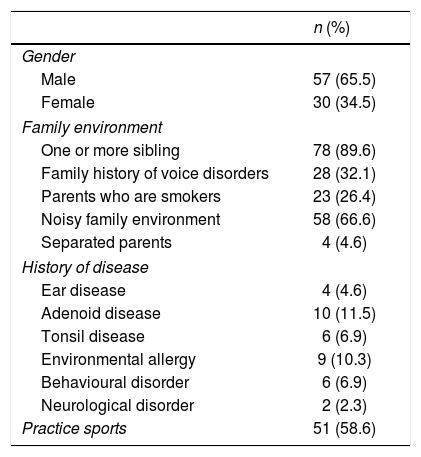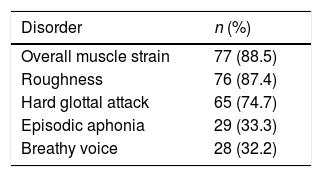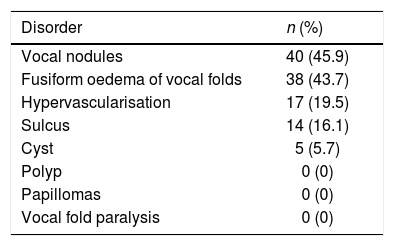The prevalence of dysphonia in children is estimated at around 6%. Dysphonia in this age group is usually due to misuse of the voice that leads to the development of vocal fold injuries. This condition can negatively affect the child's self-esteem. The aim of the study is to describe the epidemiology of voice disorders in children in our area, perform an examination of the voice, as well as identify the impact of this pathology on quality of life.
Material and methodWe present a descriptive study with 87 patients aged between 5 and 14 years old, diagnosed with dysphonia. Data collection was carried out in our centre between January 2016 and April 2019. We analysed epidemiological and clinical factors. The impact on quality of life was studied using the Pediatric Voice Handicap Index questionnaire.
Results87 patients, 57 men (65.5%) and 30 women (34.5%) were included. Mean age 8.5 years (SD: 2.08; range 4–13). The most frequent phonatory disturbance was global muscle tension (88.5%). In the laryngoscopic examination, the most frequent finding was the presence of vocal nodules (45.9%). The average score on the Pediatric Voice Handicap Index was 24.3 points in total; 4.9 on the functional scale; 17.6 on the physical scale and 1.8 on the emotional scale.
ConclusionA correct anamnesis that includes the family environment and practice of team sport is essential. The physical examination should include a laryngoscopic examination. There is an impact on the quality of life of patients with dysphonia perceived by them and their families; the physical component is perceived to be most affected. We consider a multidisciplinary approach to this condition necessary.
La prevalencia de la disfonía en la edad pediátrica se estima en torno a un 6%. La disfonía en este grupo de edad suele deberse a un uso incorrecto de la voz, que lleva al desarrollo de lesiones en las cuerdas vocales. Esta alteración puede afectar negativamente a la autoestima del niño. El objetivo del estudio es describir la epidemiología de los trastornos de la voz en la edad pediátrica en nuestra área, realizar un examen detallado de la voz, así como identificar el impacto de esta afección sobre la calidad de vida.
Material y métodoPresentamos un estudio descriptivo sobre 87 pacientes diagnosticados de disfonía con edades comprendidas entre los 5 y los 14 años. La recogida de datos se realizó en nuestro centro entre enero del año 2016 y abril del 2019. Analizamos factores epidemiológicos y clínicos. Se estudia el impacto en la calidad de vida mediante el cuestionario Pediatric Voice Handicap Index.
ResultadosSe incluyen 87 pacientes, 57 varones (65,5%) y 30 mujeres (34,5%). La edad media fue de 8,5 años (DE 2,08; rango 4-13). Los parámetros más constantes fueron tener un hermano o más (89,6%) y la práctica de deporte en equipo (58,6%). La alteración fonatoria más frecuente fue la tensión muscular global (88,5%). En el examen laringoscópico, el hallazgo más frecuente fue la presencia de nódulos vocales (45,9%). La puntuación media en el Pediatric Voice Handicap Index fue de 24,3 puntos en total: 4,9 en la escala funcional, 17,6 en la física y 1,8 en la emocional.
ConclusionesEs fundamental una correcta anamnesis que incluya datos sobre el entorno familiar o la práctica de deporte en equipo. La exploración física debe incluir el examen laringoscópico. Existe un impacto en la calidad de vida de los pacientes con disfonía, percibido por ellos y por sus familiares, siendo el físico el principal componente percibido como afectado. Consideramos necesario el abordaje multidisciplinar de esta afección.









